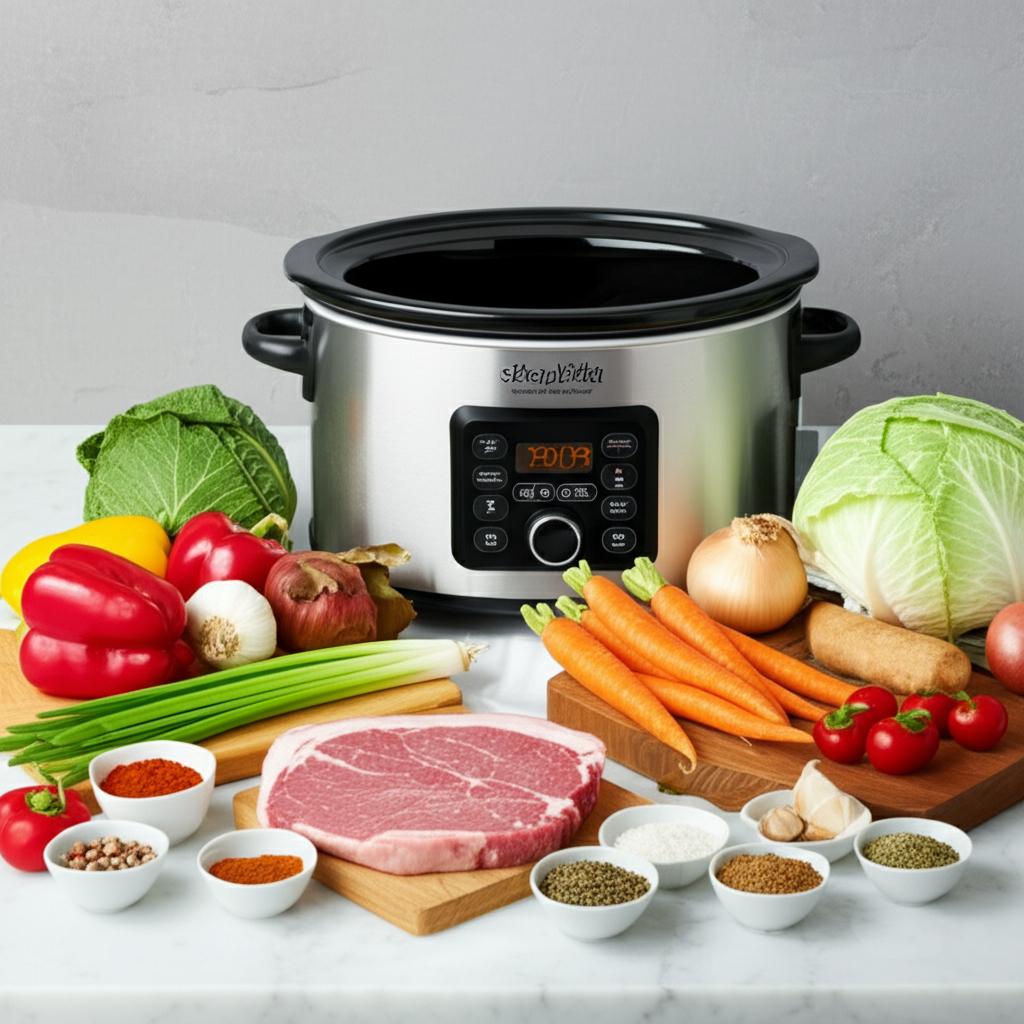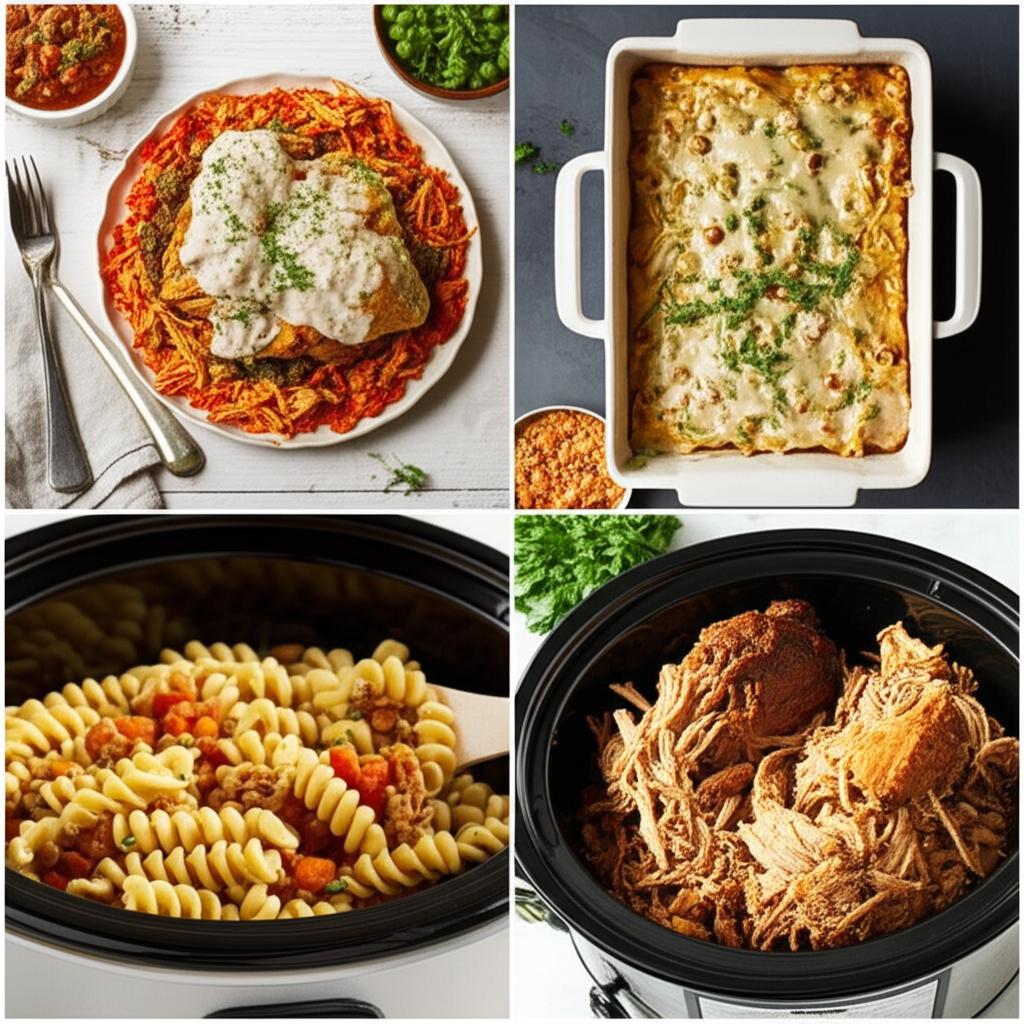
Slow Cooker Wonders: Effortless Meals for Busy Weeknights
- Crock-Pot 7 Quart Oval Manual Slow Cooker, Stainless Steel (SCV700-S-BR), Versatile Cookware for Large Families or Entertaining
- Crock-Pot 6 Quart Programmable Slow Cooker with Timer and Auto Food Warmer Setting, Stainless Steel
- BYKITCHEN Silicone Slow Cooker Liners Compatible with Ninja Foodi Possible Cooker Pro 8.5 Quart MC1000, MC1001, MC1010 Series, 2Pcs Reusable Crock Pot Liners, Ninja Possible Crock Pot Pro Accessories
Are you tired of the daily dinner dilemma? Do busy schedules leave you stressed about getting a nutritious and delicious meal on the table? If so, it’s time to discover the magic of your slow cooker! This kitchen appliance is a true culinary superhero, transforming tough cuts of meat and simple ingredients into incredibly flavorful, fall-apart dishes with minimal effort.
Say goodbye to frantic weeknight cooking and hello to the “set it and forget it” philosophy. The slow cooker allows you to do the prep work in the morning (or even the night before!), let your meal simmer to perfection all day, and come home to the comforting aroma of a ready-to-eat dinner. It’s the ultimate solution for effortless meals for busy weeknights.
Why the Slow Cooker is Your Weeknight Hero
The slow cooker isn’t just a convenience; it offers a host of benefits that make it an indispensable tool for modern households:
- Unmatched Convenience: Simply add your ingredients, turn it on, and let the slow cooker do all the work. No constant stirring or monitoring required.
- Hands-Off Cooking: Free up your evenings! While your meal simmers, you can focus on family time, hobbies, or simply relaxing.
- Deep Flavor Development: The low and slow cooking process tenderizes meats and allows flavors to meld beautifully, creating rich, complex dishes that taste like they’ve been cooking for hours (because they have!).
- Budget-Friendly: Slow cooking is fantastic for utilizing tougher, less expensive cuts of meat, like chuck roast or pork shoulder, turning them into incredibly tender and delicious meals. It also helps stretch ingredients further.
- Ideal for Meal Prep: Cook large batches of chili, stew, or pulled pork/chicken, and you’ll have healthy, homemade meals ready for days, saving you time and money.
- Reduced Dishes: Most slow cooker recipes are one-pot wonders, meaning less cleanup after dinner.
Getting Started: Your Slow Cooker Toolkit
Beyond the slow cooker itself, you don’t need much! Just basic kitchen essentials:
- Sharp Knife and Cutting Board: For prepping ingredients.
- Measuring Cups and Spoons: For accurate liquid and seasoning measurements.
- Large Spoon or Ladle: For stirring and serving.
- Basic Pantry Staples: Broth, spices, oils, canned goods.
Slow Cooker Basics: Your Step-by-Step Guide to Effortless Meals
Ready to dive in? Here’s a simple guide to getting started with your slow cooker:
Step 1: Prep Your Ingredients
- Chop and Dice: Cut all your vegetables (onions, carrots, celery, potatoes, etc.) and meats into roughly uniform sizes. This ensures even cooking. Smaller pieces cook faster, larger pieces take longer.
- Trim Meat: Trim excess fat from meat unless the recipe specifically calls for it, as fat doesn’t drain away in a slow cooker.
Step 2: Layer it Up
- Root Vegetables First: If your recipe includes hearty root vegetables like potatoes, carrots, or squash, place them at the bottom of the slow cooker insert. They cook slower and can handle direct heat.
- Meat Next: Layer your meat on top of the vegetables.
- Aromatics and Delicate Veggies: Add onions, garlic, herbs, and bell peppers on top of the meat.
- Liquids Last: Pour broth, sauces, or other liquids over everything.
Step 3: Add the Right Amount of Liquid
- Less is More: This is crucial! Slow cookers have tight-fitting lids that trap moisture. You’ll typically need much less liquid than you would for stovetop or oven cooking. Aim for liquids to come about halfway up your ingredients, unless the recipe specifies more. The ingredients themselves will release their own moisture as they cook.
Step 4: Set it and Forget It (Mostly!)
- Select Your Setting:
- LOW Setting: Ideal for most recipes. This setting cooks slowly and evenly, allowing flavors to develop fully and meats to become incredibly tender. It’s perfect for when you’re out of the house all day (6-8+ hours).
- HIGH Setting: Cooks faster, typically in half the time of the LOW setting. Use this when you have less time (3-4 hours), but be aware that it can sometimes lead to slightly less tender results or ingredients closer to the bottom burning if left too long.
- Plug In and Go: Once the lid is on, resist the urge to lift it! Every time you peek, you lose precious heat and add 20-30 minutes to your cooking time.
Step 5: The Finishing Touches
- Add Delicate Ingredients Later: Dairy (milk, cream, sour cream, cheese), fresh herbs, quick-cooking vegetables (like spinach or frozen peas), and cooked pasta should only be added in the last 15-30 minutes of cooking. Adding them too early can lead to curdling, mushy textures, or loss of flavor.
- Season and Serve: Taste and adjust seasonings (salt, pepper, spices) before serving. Garnish with fresh herbs if desired.
Pro Tips for Slow Cooker Success
Master these techniques to elevate your slow cooker meals from good to absolutely amazing:
- Brown Your Meats First (Optional but Recommended): While not strictly necessary, taking a few minutes to sear your meat in a hot pan before adding it to the slow cooker adds a wonderful depth of flavor and color (the Maillard reaction). This makes a noticeable difference in the final taste.
- Control Your Liquids Wisely: As mentioned, always reduce the amount of liquid you’d normally use in a conventional recipe. Most recipes only need enough liquid to cover about half of the ingredients.
- Mind Your Dairy and Tender Veggies: To prevent curdling or mushiness, add milk, cream, cheese, fresh herbs, and delicate vegetables (like spinach, bell peppers, or zucchini) only during the last 30-60 minutes of cooking.
- Spice it Up Strategically: Dried herbs and spices can go in at the beginning. Fresh herbs, however, should be stirred in just before serving to preserve their vibrant flavor and aroma.
- Resist the Urge to Peek! This cannot be stressed enough. Every time you lift the lid, you release accumulated heat and steam, extending the cooking time significantly. Trust the process!
- Food Safety First: Always ensure meat is thawed before adding it to the slow cooker. Once cooked, perishable foods shouldn’t sit in the “warm” setting for more than 2-4 hours. Always check the internal temperature of meats to ensure they are fully cooked (e.g., chicken to 165°F/74°C).
- Make it a Meal Prep Master: Cook larger quantities than you need for one meal. Leftovers freeze beautifully and provide convenient meals for future busy days. Divide into single-serving containers for grab-and-go lunches or dinners.
Common Slow Cooker Mistakes to Avoid
Even seasoned cooks can make these common blunders. Learn from them to ensure your slow cooker creations are always a success!
- Adding Too Much Liquid: This is the most common mistake. It results in a watery, diluted dish. Remember, less liquid is needed in a slow cooker because moisture doesn’t evaporate.
- Lifting the Lid Too Often: As discussed, this significantly prolongs cooking time and messes with the internal temperature. Leave it alone!
- Overcrowding Your Cooker: Filling your slow cooker to the brim can lead to uneven cooking, with some ingredients undercooked and others overcooked. Aim to fill it between half and two-thirds full.
- Adding Dairy or Delicate Ingredients Too Early: This leads to curdled sauces and mushy vegetables. Wait until the end to incorporate these.
- Choosing the Wrong Cut of Meat: Lean cuts like chicken breast or pork loin can dry out and become tough in a slow cooker. Tougher, fattier cuts like chuck roast, pork shoulder, and chicken thighs are ideal as the low, slow heat breaks down their connective tissues, making them incredibly tender.
- Not Adjusting Recipes: Don’t just dump a stovetop or oven recipe directly into your slow cooker. You’ll need to reduce liquids, adjust cooking times, and consider the order of ingredient addition. Look for recipes specifically designed for slow cookers when you’re starting out.
Unleashing Your Creativity: Endless Possibilities!
The beauty of the slow cooker lies in its versatility. Once you understand the basics, you can experiment with countless dishes:
- Hearty Chilis and Stews: Classic comfort food for cold evenings.
- Tender Roasts: Perfect for pot roasts, pork shoulder, or even whole chickens.
- Pulled Meats: Ideal for sandwiches, tacos, or salads (pulled pork, pulled chicken, shredded beef).
- Flavorful Soups: From vegetable to creamy chicken noodle.
- Curries and Ethnic Dishes: Let the spices meld beautifully over hours.
- Even Desserts! (Yes, you can make cakes and cobblers!)
Embrace the magic of your slow cooker! It’s more than just a kitchen appliance; it’s a tool for simplifying your life, reducing stress, and bringing delicious, comforting, and effortless meals to your table even on the busiest of weeknights. Happy slow cooking!
- Crock-Pot 7 Quart Oval Manual Slow Cooker, Stainless Steel (SCV700-S-BR), Versatile Cookware for Large Families or Entertaining
- Crock-Pot 6 Quart Programmable Slow Cooker with Timer and Auto Food Warmer Setting, Stainless Steel
- BYKITCHEN Silicone Slow Cooker Liners Compatible with Ninja Foodi Possible Cooker Pro 8.5 Quart MC1000, MC1001, MC1010 Series, 2Pcs Reusable Crock Pot Liners, Ninja Possible Crock Pot Pro Accessories
FAQ
Q. What makes slow cooking ideal for busy weeknights?
A. Slow cooking is a game-changer for busy weeknights because it’s largely hands-off. You can do the minimal prep work in the morning or even the night before, set your ingredients in the slow cooker, turn it on, and leave it to cook throughout the day. By the time you get home, a hot, flavorful, and often comforting meal is ready to serve, eliminating the stress and time commitment of traditional dinner preparation after a long day.
Q. Can I really leave my slow cooker unattended all day while I’m at work? Is it safe?
A. Yes, absolutely! Modern slow cookers are specifically designed for safe, unattended operation over extended periods. They are built with safety features, including well-insulated exteriors and precise temperature controls, making them incredibly energy-efficient and safe to leave on throughout your workday. Always ensure your slow cooker is placed on a stable, heat-resistant surface and away from any flammable materials.
Q. Do I need to brown meat before putting it in the slow cooker for better flavor?
A. Browning meat before adding it to the slow cooker is optional but highly recommended for most dishes. It adds a deeper, richer flavor profile (thanks to the Maillard reaction) and can improve the texture of the meat. However, if you’re truly short on time, you can skip this step, and your meal will still be delicious and tender due to the slow cooking process.
Q. What kinds of meals are best suited for slow cooking on a busy weeknight?
A. Slow cookers excel at dishes that benefit from long, gentle cooking, which helps tenderize tougher cuts of meat and allows flavors to meld beautifully. Ideal meals include hearty stews, chilis, pot roasts, pulled pork or chicken, soups, comforting casseroles, and even some types of pasta sauces or warm dips. Anything that can simmer slowly will turn out wonderfully.
Q. Can I prepare ingredients the night before to save even more time in the morning?
A. Absolutely, this is one of the best strategies for truly effortless slow cooking on busy mornings! You can chop all your vegetables, cut your meat, measure out spices, and even prepare sauces or liquids the night before. Store everything in airtight containers in the refrigerator, then simply combine them in the slow cooker insert when you wake up. For safety, keep raw meat separate from other ingredients until just before cooking.
Q. My slow cooker meals sometimes turn out too watery. How can I prevent this?
A. Slow cookers are very efficient at retaining moisture, so you generally need significantly less liquid than you would for a conventional recipe. A good rule of thumb is to start with about half to two-thirds the amount of liquid a stovetop or oven recipe calls for. If your dish does end up too watery, you can often thicken it towards the end of cooking by stirring in a cornstarch or flour slurry, or by removing the lid for the last 30-60 minutes to allow some liquid to evaporate.
Q. Is it complicated to clean a slow cooker after using it all day?
A. Not at all! Most modern slow cookers come with a removable stoneware or ceramic insert that is non-stick and often dishwasher-safe, making cleanup incredibly easy. For any stubborn food residue, a quick soak in warm, soapy water usually loosens it right up. The exterior unit typically just needs a simple wipe-down with a damp cloth.


